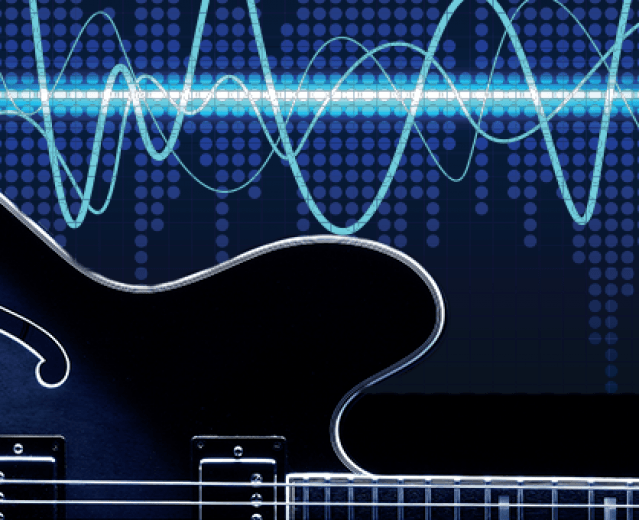When and how the wish of
distorted sounds began and how it expanded in the '60s.
In this article we are going to
deal with the early known examples of distortion, particularly with the first fuzz,
a pedal effect (also called stompbox) dedicated to distortion.
In this
article we will tell you about the birth of the first distorted sounds and by
what means they were obtained.
Before
continuing, it is useful to know the differences
among the various pedal effects for guitar and bass. For this purpose I suggest you to read the Soundsation blog article about Choosing the
right overdrive/distortion stompbox.
Distortion
forerunners
Until the mid
'60s guitar sound distortion was seen rather badly, though it could
occur for technical reasons, for example as a light crunch in jazz or blues
recordings. Pop, surf, country and rockabilly trendy sounds were generally
clean, if not really crystalline: an example for all is the Stratocaster® guitar sound of Hank Marvin (born Brian Robson Rankin) with the English band The Shadows, of
which the big hit Apache of 1960 is very popular.
Blues musicians' recordings were less
crystalline, such as the ones of Sister Rosetta Tharpe, Hubert Sumlin (with
Howlin’ Wolf), or the ones of Link Wray, Chuck Berry, Tommy Tedesco in some
sessions, and others. Sometimes it happened by choice, more often for
amplification, miking and mixer limitations.
For example, Paul
McCartney claims (on “Guitar Player” magazine of October 1992) the Beatles
loved to make the studio mixer distort and compress the sound. He tells a
distorted acoustic guitar track was recorded for Ob-La-Di, Ob-La-Da (1968) just letting
the VU meter needle stay in the red zone, thus raising the track level over the
saturation limit (the orientation of a magnetic tape particles
beyond which it is no more possible to orient them again for further recording).
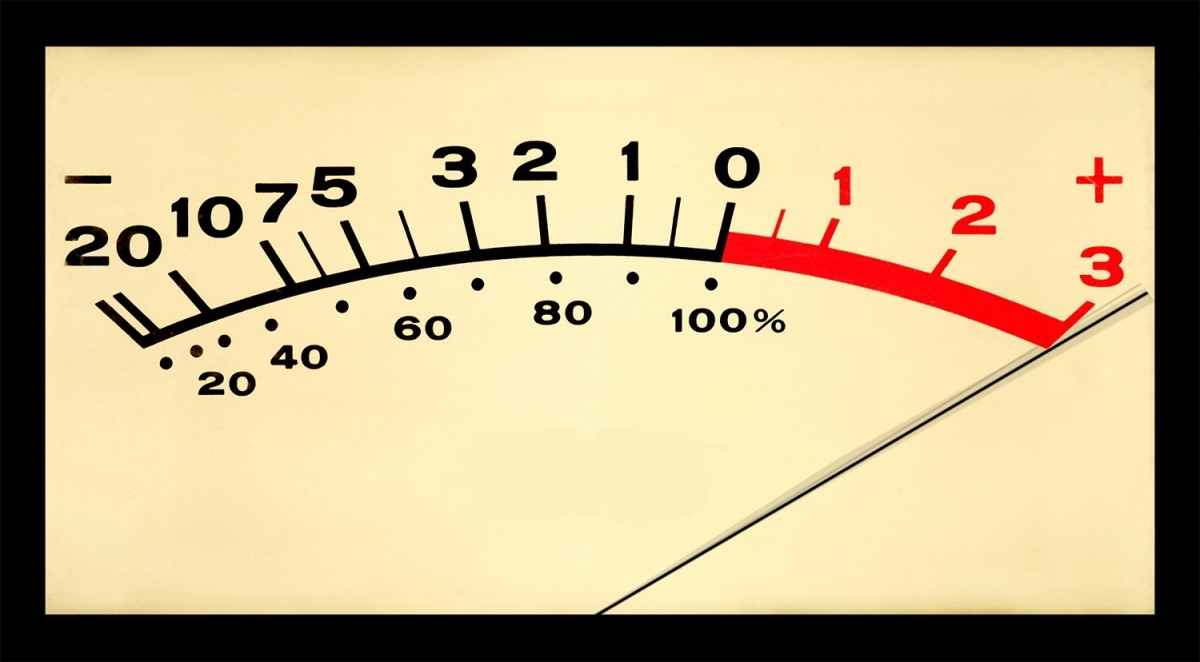
In California,
well known pedal steeler Orville Red Rhodes (Monkees,
Beach Boys, Byrds) was working as a session man since 1960. Keen on electronic,
he had built something similar to a fuzz for his musician friends. The first
example of explicitly wanted distortion is listenable in 1962 Ventures'
song The 2,000 Pound Bee, and it comes from one of Rhodes' effects. The
song title is revealing!
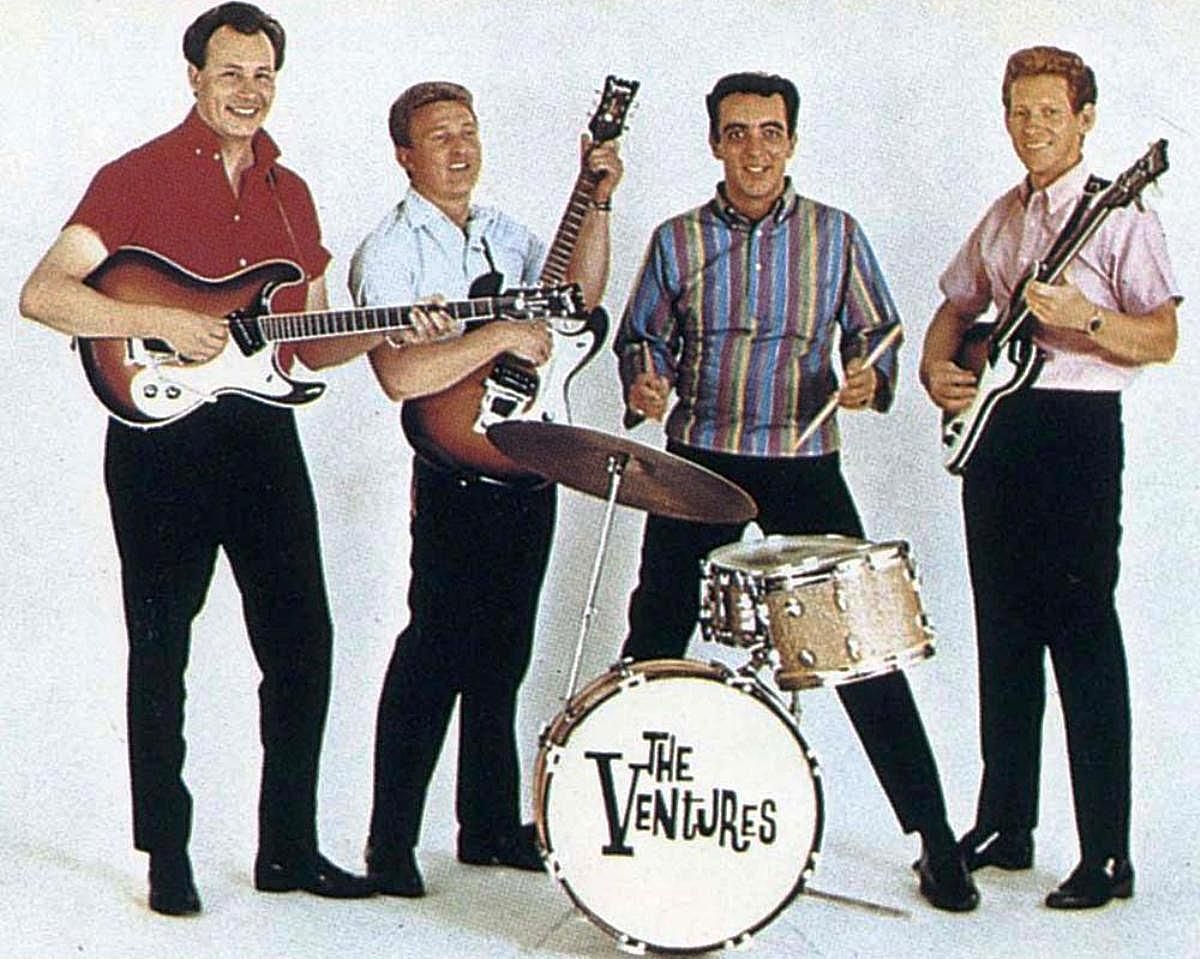
The Maestro Fuzz-Tone
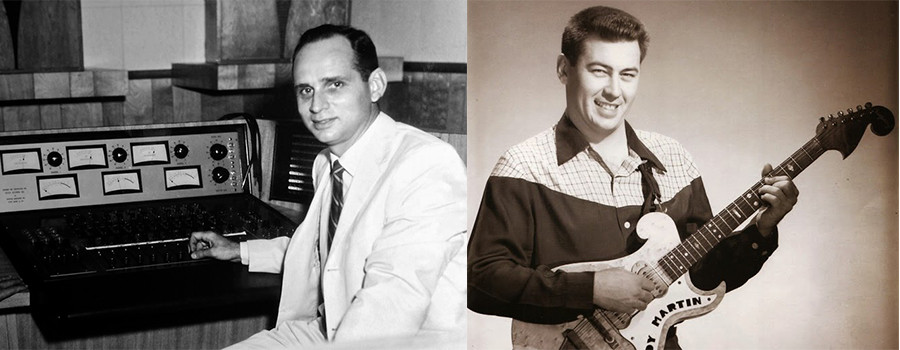
The previous
year, 1961, an event that officially opened the doors to distortion happened,
and it started from a bass, not a guitar! In fact, during the recording session of a 6 string bass
played by guitar player Grady Martin in Nashville, the sound engineer Glen
Snoddy (in the B&W photo) noticed that the recorded sound was defective.
Some say the problem was in Martin's amplifier, whereas others claim that the
bass was directly plugged in a mixer input and made it distort. It remains a
fact that the distorted track was appreciated by the producer and used on
country singer Marty Robbins' hit Don’t
Worry. Shortly after, in the arc of 1961, Grady Martin released his own
song The Fuzz, based on the same distorted sound.
Based on that
early “technical mistake”, Glen Snoddy and TV engineer Revis Hobbs patented the
first distortion box, actually built by Gibson: the Maestro Fuzz-Tone.
It was operated via three germanium transistors that gave three
gain stages. At first it was powered by one and later by two type C batteries
(1,5 Volts each, so only 3 Volts in total!). Initially Gibson integrated the
circuit in its EB-0F bass and EBSF-1250 bass and guitar double-neck (F stays
for Fuzz). Afterwards, in 1962, it was offered as an independent effect named Maestro
FZ-1. It had two knobs: Volume and, curiously, Attack for distortion. This
definition was proposed on other following models too.
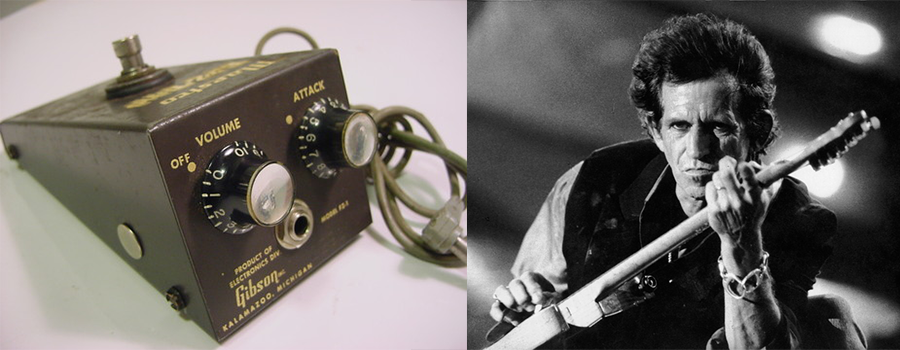
Success did not reach the FZ-1 until 1965,
when Rolling Stones' Keith
Richards used one for a guide track
of (I Can't Get No) Satisfaction, temporarily substituting a horn
section riff.
Finally the song was released with the famed distorted guitar riff. At
first Richards was not enthusiast of it, but he used a Maestro fuzz also during
the following US tour, thus starting a new chapter in rock music history.
It is worth
pointing out now that one of the most successful crunch sounds of all times,
The Kinks' You Really Got Me riff one, had arrived the year before,
1964. Guitar player Dave Davies got it cutting a speaker with a razor blade. He
claimed this happened for a fit of anger due to a heartbreak, but some say it
happened during a breach with his brother and Kinks' singer Ray, who likewise
supported he took that action.
In 1965
Maestro FZ-1 circuit was improved and the pedal was renamed FZ-1A. In 1968 Robert Moog – engineer and inventor of the synthesizer in
his name – further transformed it replacing germanium transistors (left
in photo) with steadier silicon ones (right in photo) and finally
powering the unit with a 9 Volts battery (model FZ-1B).
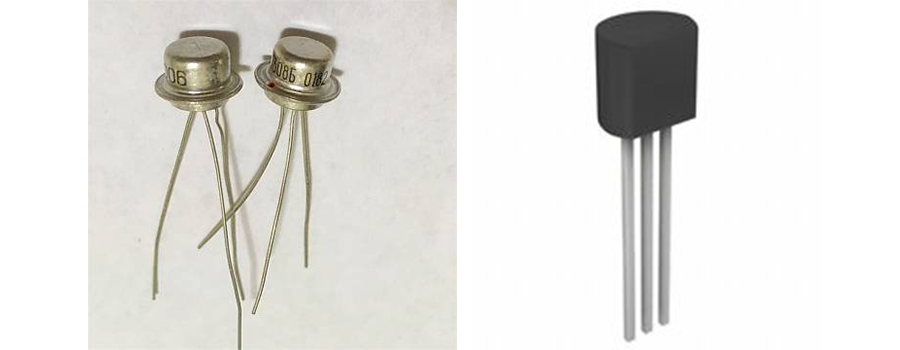
New fuzzes from the United Kingdom
Those
described so far are not the only known signs of '60s distortion craving. Dick
Denney – musician, technician and legendary creator of Vox amplifiers –
also designed a fuzz in 1965: the compact Vox Distortion Booster, that
English doubtful company Jennings did not want to market until the Maestro
success was clear. The box had to be directly plugged into the guitar jack
plug, just like the 1969 LPB-1 booster from U.S. company Electro-Harmonix. The LPB-1 box was also used
to house the Muff Fuzz circuit, actually a
mild overdrive.
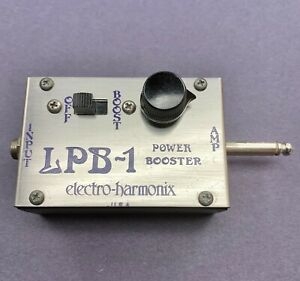
In 1964
session man Victor Flick (his guitar played the theme of James Bond films)
turned to technician Gary Hurst (former Vox and Elka) to get some
modifications at his Maestro, as he said its sound was too thin, rough and poor
in sustain. Thus the first Tone Bender arrived in 1965 (with a 9V
battery and true bypass circuit since the beginning!). First among the
guitarists, Jeff Beck appreciated it, then Jimmy Page, Mick Ronson, Pete
Townshend and many others.
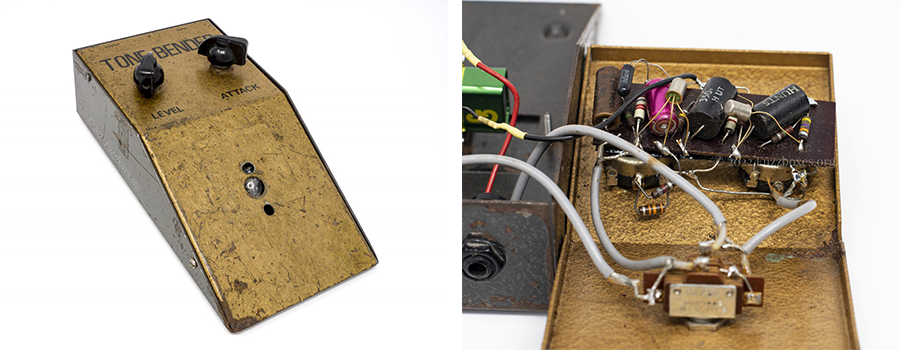
Soon the pedal
was marketed as Sola Sound Tone Bender, followed by other similar products with
the same name built by Vox, Electronic Sounds and the Italian JEN
Elettronica in 1967 (early Italian units were made by Eko).
Other fuzzes
were offered by Baldwin-Burns (Buzzarounds), Carlsbro (Fuzz-Tone) and WEM (Pep
Box).
Hence 1965 was
an year of big technical and musical breakthrough for the electric guitar
sound. Great soloists as Eric Clapton, Jimmy Page and Jeff Beck were making
distortion a final timbre and expressive element.
The Fuzz Face
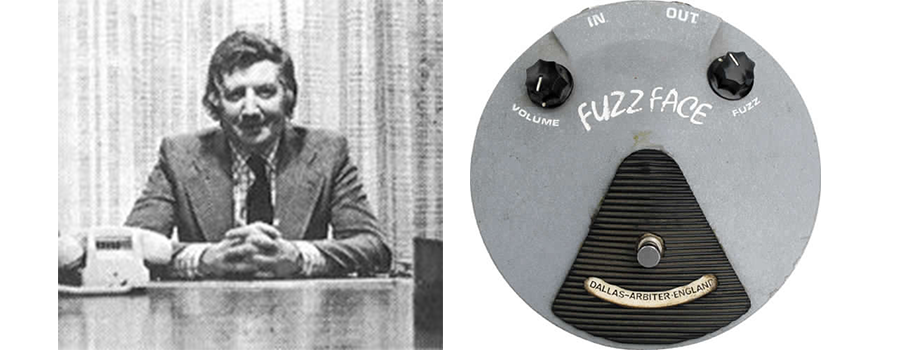
Jimi Hendrix
was probably the most renowned and influential musician in determining the huge
success of a fuzz built by English drummer and businessman Ivor Arbiter:
the Fuzz Face. It was equipped with germanium transistors from 1966 to
about 1968, later with silicon ones, and it featured a few parts: just two
transistors, some capacitor and resistor, all housed in a microphone stand
base.
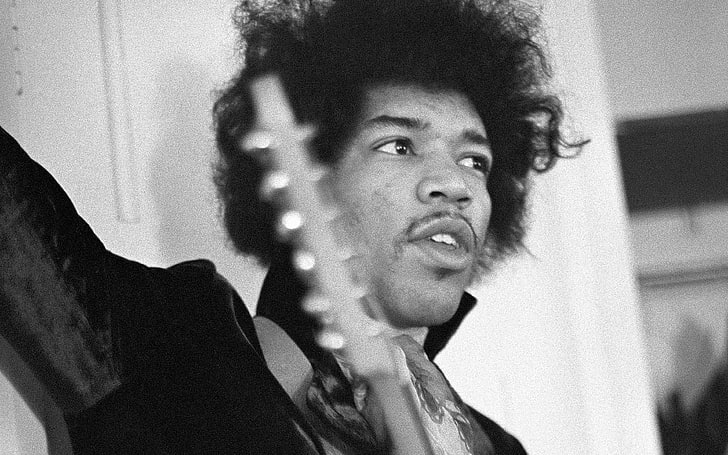
Roger Mayer
was a well known designer of recording devices, analog synths and the Octavia
pedal, as well as Jimi Hendrix's sound engineer. He tells that the guitarist
used to buy big quantities of Fuzz Faces to be able to select the more stable
and consistent in sound ones (at that time a Fuzz Face price was about a fifth
of a Maestro). In fact it is known that germanium transistor operation depends
on temperature and power supply, a problem that silicon transistor development
solved. For the same reason, Mayer reports that, unlike live guitar sounds,
Hendrix's recorded ones were actually processed by proper pre-amplification
(before the pedal) and EQing (on the mixer).
Due to
financial problems, in 1968 Arbiter's company merged with Dallas Musical LTD,
giving birth to the Dallas Arbiter Fuzz Face brand. Later CBS took over
and production finished in 1975.
From fuzz on
This article
finishes with a mention of the revered Electro-Harmonix Big Muff Pi, a
distortion box that was designed in 1969 by Mike Matthews and Bob
Myer on the basis of the previous Axis Fuzz. Some do not consider it
exactly a fuzz, because, besides using three or four transistors (according to
models), it features diodes for clipping and some more circuit complexity. It
was the beginning of a new course that would have lasted throughout the '70s.
We talk about this in the article Choosing the
right overdrive/distortion stompbox.
In conclusion, a recommendation: any fuzz replica you decide to
put in your rig, consider these pedals perform at best if they can see
the guitar pickup. Therefore, first position on pedalboard and no buffer!
Fabrizio Dadò
References
Guitar Player Magazine no.274 - October 1992 (Miller Freeman
Publications)
Axe – Periodico per
chitarristi no.171 - March 2012 (Edizioni Palomino)
http://www.sixstringsvintage.com
TAGs: music-instruments, fuzz, electric-guitar, distortion, rock-guitar-sound,
